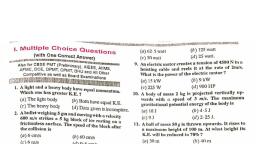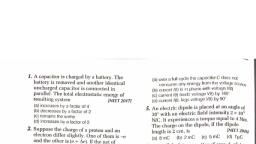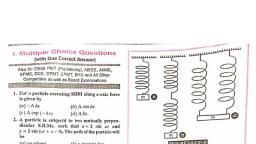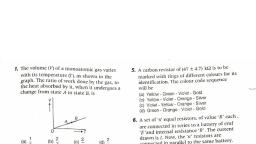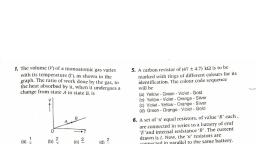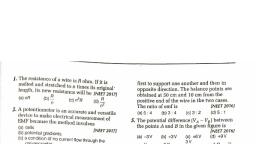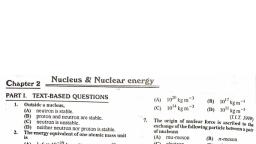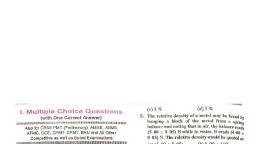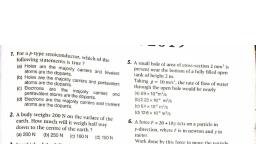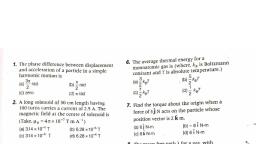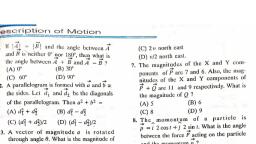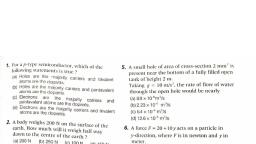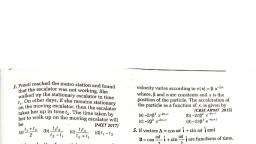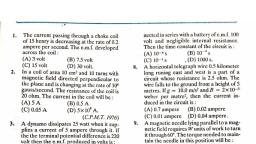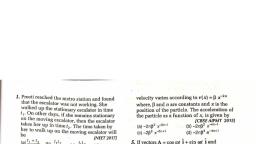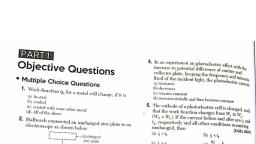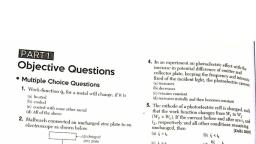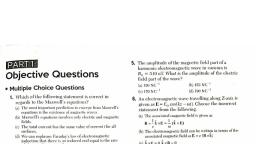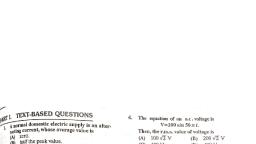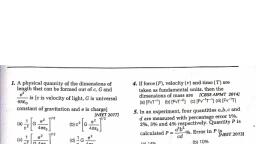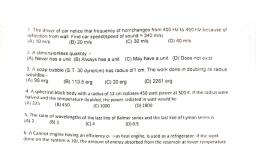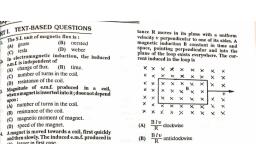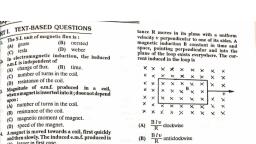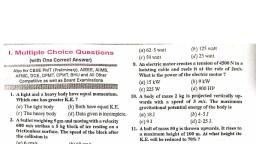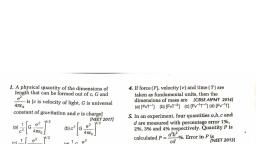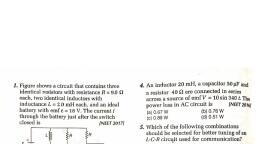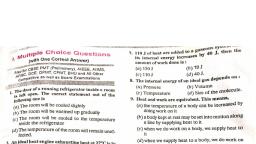Page 1 :
1, Preeti reached the metro station and found, that the escalator was not working. She, walked up the stationary escalator in time, t,. On other days, if she remains stationary, on the moving escalator, then the escalator, takes her up in time f,. The time taken by, her to walk up on the moving escalator will, be . [NEET 2017], , tytts tt th =, , (a) a (b) Gah ati ito) Gin Ot, —ty, , 2. If the velocity of a particle is v = At + Bt’,, , where A and B are constants, then the, distance travelled by it between 1s and 2s, , is [NEET 2016), (a) 3A4+78 wi Za+ ZB, , A,8 a, , Dye (d) =A+ 48, (c) a 3, , 3. Two cars P and Q start from a point at the, , same time in a straight line and their, positions are represented by, Xp (t) = at +bt* and Xo (t) = ft- 0. At, , what time do the cars have the same, , velocity? INEET 2016], a-f att gy atl wy _foa, Miss x e-0 (tab) aa Ob), , 4. A particle of unit mass undergoes, one-dimensional motion such that its, , velocity varies according to v(x) =B x*", , where, B and n are constants and x is the, , position of the particle, The acceleration of, , the particle as a function of x, is given by, (CBSE AIPMT 2015], , (b} -2np? x*"*, , (d) ~2np? evaert, , (a) -2np? x21, , (c) -2p7 an 1, 5. vectors A = cos wt i +sin wt j and, , B= cos Si + sin & j are functions of time,, , then the value off at which they are, , orthogonal to each other, is[CBSE AIPMT 2015], , at a at =, fat== (t= wt=Z (ae=0, , 6. A stone falls freely under gravity. It covers, distances h,, h, and h, in the first 5s, the, next 5s and the next 5s respectively. The, relation between h,,, and h, is [NEET 2013), , (a) =2hy= Sry fo) = Me =, (0) hy = 3h, and hy = 3h, (d) hy =p = hy, 7. The motion of a particle along a straight, line is described by equation, x=B+120-1°, , where, x is in metre and ¢ in sec. The, retardation of the particle when its velocity, becomes zero, is {CBSE AIPMT 2072}, (a) 24ms" (b) zero —(c) Gms* (G) 12 Ms
Page 2 :
8. A boy standing at the top of a tower of 20 m,, height drops a stone. Assuming, g =10 ms“,, the velocity with which it hits the ground is, (a) 20 m/s [CBSE AIPMT 2011], (b) 40 m/s, (c) 5ms, (d) 10 rvs, , 9. A body is moving with velocity 30 m/s, towards East. After 10s, its velocity becomes, 40 m/s towards North. The average, acceleration of the body is [CBSE AIPMT 2071], (a) 7m/s® (b) V7 m/s? (c)5m/s* (d) 1 m/s?, , 10. A ball is dropped from a high rise platform, at =0 starting from rest. After 6 s, another, ball is thrown downwards from the same, platform with a speed v. The two balls, meet at f = 18 s. What is the value of vu?, , (Take g = 10 ms) ICBSE AIPMT 2010], (a)74ms"' (b)55ms~' (c) 40ms~' (d) 60ms~*, , 11. A particle moves a distance x in timet, according to the equation x = (t +5)’. The, , acceleration of particle is proportional to, , (CBSE AIPMT 2010], (a) (velocity)*/* (b) (distance)*, (c) (distancey * (d) (velocity)?, , 12. A particle starts its motion from rest under, the action of a constant force. If the distance, covered in first 10 s is s, and that covered in, , the first 20s iss,,then [CBSE AIPMT 2009], (a) s, =2s, (b)s, =3s,, (c)s, =45, (d) s, =s,, , 13. A bus is moving with a speed of 10 ms™' on, a straight road. A scooterist wishes to, overtake the bus in 100 s. If the bus is ata, distance of 1 km from the scooterist, with, what speed should the scooterist chase the, , bus? {CBSE AIPMT 2009], =1 “1, (9 25m" (2) me, ms, , 14. A particle moves in a straight line with a, constant acceleration. It changes its, velocity from 10 ms“ to 20 ms while, passing through a distance 135 m int sec., The value oft is ICBSE AIPMT 2008}, 10 «= 18 = 12a, , 15. A particle shows distance-time curve a,, given in this figure, The maximum, instantaneous velocity of the particle jg, around the point ICBSE Alp 2004, , D, , Distance, a, , A 78, Time, (aB (b)C (c)D (d) A, , 16. The distance travelled by a particle starting, from rest and moving with an acceleration, , 4 wns, in the third-second is, 3 [CBSE AIPMT 2008], , (a)6m (b) 4m () 2m (a) 2m, 3 3, , 17. A particle moving along x-axis has, acceleration } at time f, given by, , f=f(1-t where f, and T are, , constants. The particle at t = 0 has zero, velocity. In the time interval between t =0, and the instant when f = 0, the particle's, velocity (v,) is [CBSE AIPMT 2007], , @sT ©) ; fT? (GT? — d) 3 ‘0, 18. A car moves from X to Y with a uniform, , speed v, and returns to X with a uniform, speed v,. The average speed for this round, , , , trip - (CBSE AIPMT 2007], fe) (o) feu (cy gy) Ut, uy + uy uty, 2, , 19. The position x of a particle w.r.t. time t, along x-axis is given by x=9t? —1', where, x is in metre and t in sec. What will be the, position of this particle when it achieves, maximum speed along the + x direction?, , [CBSE AIPMT 2007], , (a) 32m = (b) 54m_—s (ce) BI Mm (d) 24m, , 20. Two bodies A (of mass 1 kg) and B (of, mass 3 kg) are dropped from heights of 16 m, and 25 m, respectively. The ratio of the time, taken by them to reach the ground is, , (CBSE AIPMT 2006], , (a)-5/4 (c) 5/12 (d) 4/5, , (b) 12/5
Page 3 :
21., , 22., , 23., , A particle moves along as, , \ loves ga straight line OX., , Ata time f (in second), the distance x (in, , metre) of the particle from O is given by, xedo4+120-0, , How long would the particle travel before, , coming to rest? {CBSE AIPMT 2006}, (a) 24m (b) 40m (ec) 56M) 16m, The displacement x of a particle varies, , with time (as x = ae” + be, where a,b, a, and f are positive constants. The velocity, of the particle will {CBSE AIPMT 2005], (a) decrease with time, , (b) be independent ofa and, , (c) drop to zero when a = B, , (d) increase with time, , A man throws balls with the same speed, , vertically upwards one after the other at an, , interval of 2 s. What should be the speed of, , the throw so that more than two balls are, , in the sky at any time? (Take g = 9.8 m/s"), [CBSE AIPMT 2003), , (a) Any speed less ihan 19.6 ms, , {b) Only with speed 19.6 m/s, , (c) More than 19.6 ms, , (d) At least 9.8 m/s, , 24. If a ball is thrown vertically upwards with, , 25., , ed during the last, (CBSE AIPMT 2003], , 6) gt?, 59, , u, the distance cover, t sec of its ascent is, , (aut - Zot" (by + gt)t (out, , Astone is thrown vertically upwards., , When stone is at a height half of its,, , maximum height, 2 then, , the maximum height attained by the stone, , is(g =10m/s") {CBSE AIPMT 2001], , fam —e) 10m (c) 15m (d) 20m, aight line such, , i Jong a str, 26. A particle moves # ng irs given, , 27. Acar moving with a spee, , that its displacement at any, by s eat +7t7 +14lt 5 The acceleration, , of the particle at t=1sis {CBSE AIPMT 2000], , (a) 18mis*_ (b) 32 mis? (c) 29s" (0) 2ams, , d of 40 ant oe, rt d after 2m by applying brakes., , te aoeae cal is mi with a speed of 80, , km/h, what is the minimum stopping, , distance? [CBSE AIPMT 1998], (a) 8m {b) 2m, , (4m em, , 32, The water, , 28. If a car at rest, accelerates uniformly toa, , speed of 144km/h in 20s, it covers a, , distance of {CBSE AIPMT 1997], {a) 2880 m {o) 1440 m, (c) 400 m (a) 20m, , 29. The position x of a particle varies with, , time t, as x= at? — bt®. The acceleration of, the particle will be zero at time! equals to, , [CBSE AIPMT 1997], (a) zero (bo), 2a _, Os @>, , 30. If a ball is thrown vertically upwards with a, , velocity of 40 m/s, then velocity of the ball, after 2 will be(g = 10 m/s*), , {CBSE AIPMT 1996), (a) 15 ms (b) 20 mvs, (c) 25 ms (d) 28 mis, , 31. Three different objects of masses ™, m, , and m, are allowed to fall from rest and, from the same point O along three different, frictionless paths. The speeds of the three, ing the ground will be in, , [CBSE AIPMT 1995], (bp) m, :2m, : 3m, gt:, , m mz Ms, , drops fall at regular intervals, from a tap 5 m above the ground. The, , drop is leaving the tap at an instant when, , the first drop touches the ground. How lar *, , above the ground is the second dro, instant ? (Take g = 10 m/s*), [CBSE AIPMT 1995], , (a) 1.25m (b) 250m {c) 3.75 m (d) 5.00 m, , 33. A body is thrown vertically upwards from, height, , the ground. It reaches a maximum, of 20 m in 5 s. After what time it will reac:, , the ground from its maximum height, it [CBSE AIPMT 1995), , position ?, (a25s (0) 5S (ce) 108 (o) 258, , 34, A stone released with zero velocity 3, , the top of a tower, reaches t is?), s, The height of the tower es toa 195), , gen yea", , (a) 20m (bo) 40m
Page 4 :
12, , 35. Acar accelerates — * a _, for some time, a ter which 1, Gecnloreles ata constant rate B and comes, to rest. If the total time elapsed ist, then, acquired by the car, , i velocity, _ A ey CBSE AIPMT 19941, top w -B° |,, (a (“3"} wf 2, a+ BI d (2%), {c) <8 (d) ah, , 36. A particle moves along a straight line such, thal its displacement at any time tf is given, bys=(t° -61° +3f+4)m, The velocity when the acceleration is zero,, is [CBSE AIPMT 1994], (a) 3ms" (0) -12 ms*, , (c) 42ms" (a) -9ms*, , 37. The displacement-time graph of moving, particle is shown below., , Time t, , The instantaneous velocity of the particle, is negative at the point — [CBSE AIPMT 1994], {aD (b) F, , tc (a) E, , 38. A body starts from rest, what is the ratio of, the distance travelled by the body during, , the 4th and 3rd s? [CBSE AIPMT 1993}, 7 5, , (a) 5 (6) =, 7 3, , (c) 3 (d) ;, , 39. A train of 150 m length is going towards, North direction at a speed of 10 m/s. A, parrot flies at the speed of 5 m/s towards, South direction parallel to the railways, track. The time taken by the parrot to cross, the train is ICBSE AIPMT 1992), , (12s 8S (15s 10s, , following curves does not, , tion in one dimension?, {CBSE AIPMT 1992), =, , v, @) (b) |, aw, , lO *, , Li, , 40. Which of the, represent mol, , L__-______—_», , , , , , af, , rst one-third distance, at a speed of 10 km/h, the next one-third at, 20 leah and the last one-third at 60 km/h,, , ead of the bus is, oa [CBSE AIPMT 7991), , fa) 9 knvh (b) 16 kenvh (c} 18 km/h (d) 48 kenvh, , 42. A car moves a distance of 200 m. Il covers, the first-half of the distance at speed, 40 km/h and the second-half of distance at, speed vkm/h . The average speed is, , 48 km/h, Find the value of v., [CBSE AIPMT 1991], , (a) 56 krvh (b) 6Oknvh (c} 50 km/h (d) 48 keh, 43. \ body dropped from top of a tower fall, , through 40 m during the last two seconds, , of ils fall. The height of tower is, , (¢ =10 m/s*) {CBSE AIPMT 1991], , fa)60m = (b)45m = (ce) BOM (d) 50m, 44. A car covers the first-half of the distance, , between two places al 40 km/h and other, , half at 60 km/h. The average speed of the, , car is [CBSE AIPMT 1990}, , (a) 40 kmh (b) 48 kmvh (c) SO kmvh (dl) GO kmvh, , 45. big will be the ratio of the distance moved, ya freely falling body from rest in 4th and, Sth second of journey? [case AIPMT 1989], (4:5 (7:9 © | 16-25 (a) 1-4, , 46. ae moving along a straight road witha, mone on It passes through two, aaa = Q separated by a distance with, The m/h and 40 km/h respectively., , locity of the car midway between P, , 41. Abus travelling the fi, , and Q is, (8) 33.3 kn ICBSE AIPMT 1988], (©) 25 V2 knwn (0) 20 V2 kmvh, , (d) 035 km/h
